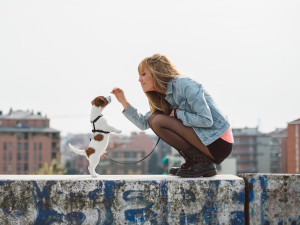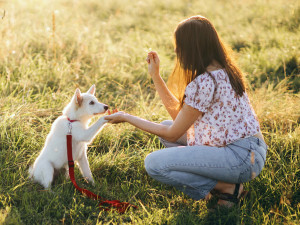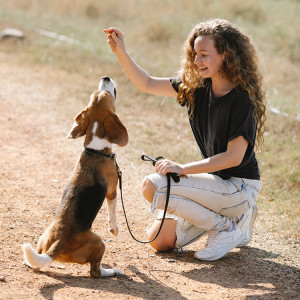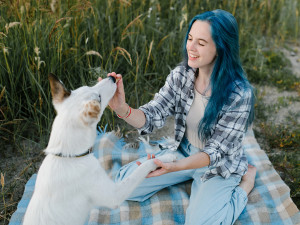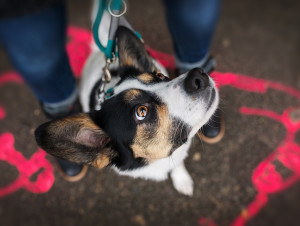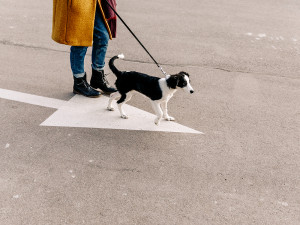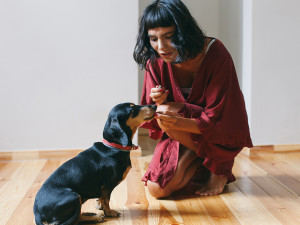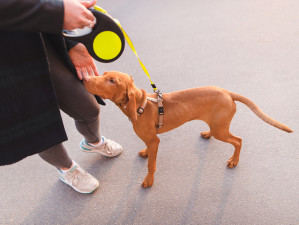How to Train a Dog to Stay
The first rule of thumb for you: patience.
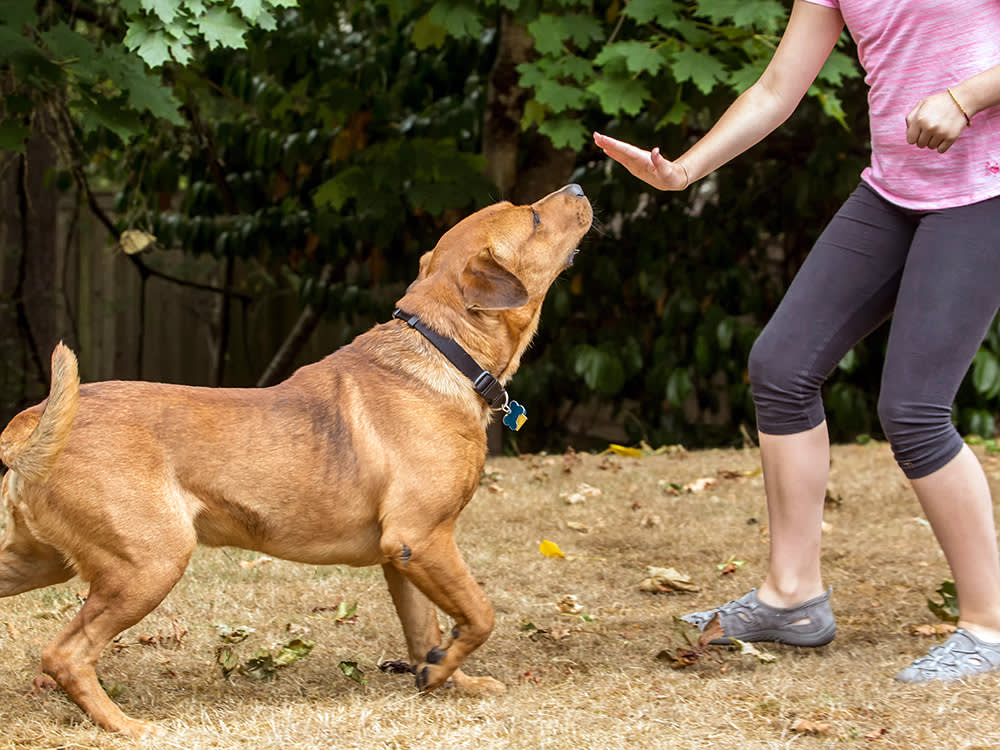
Share Article
In This Article:
How to Train a Dog to Sit and Stay Common Dog-Training Cue Mistakes to Avoid Why Won’t My Dog Listen to Cues?
Training your dog to stay is a key skill that helps keep them safe and well-behaved in various situations. By using positive reinforcement techniques and gradually increasing the duration and distance of the “stay” cue, you can teach your dog to stay in place until you release them.
How to train a dog to sit and stay
Start with a “sit” or “down” position.
First, choose which behavior you would like your dog to “stay” in — you can pick “sit” or “down.” Your dog must understand the basics of how to achieve these positions before you can teach them how to stay still in them.
Use treats to work on impulse control.
Teaching your dog impulse control is a great way to build their understanding of not moving when asked. Begin with a dog treat in the palm of your hand and hold the treat about 10 inches from your dog’s face. If your dog moves for the treat, close your hand, if they stay still and do not move, bring your hand to your dog and reward them with a treat (do not let the dog come to your hand to get the treat). When working on impulse control, you will not use any cues. The action alone of closing your hand when your dog moves will be enough communication to train your dog what to do.
Continue to increase the duration with your palm open so that your dog has to wait before being rewarded with the treat. Impulse control helps you train a dog who waits to get what they want and looks to you for confirmation, rather than pouncing.
Once your dog can stay in the position and waits to be rewarded you can begin to make it harder. This is where your patience comes into play; your dog is used to following you around, so take your time and go slow. Remember, when training your dog, setting them up for success during the initial training sessions and preventing them from making mistakes will make the overall process easier.
Add movement to the training.
Next, you will continue to practice impulse control and begin to add movement to it. You no longer need a treat in your hand. Keep it in your treat pouch some where accessible to reward your dog quickly when they get something right. Take a small step away from your dog (maybe five inches). If your dog stays in one spot, reward them.
Your dog may tilt their body slightly but should not move their feet from where they are. Each time you reward your dog with a treat, count to five then release them with the word “free.” When you tell your dog “free,” allow them to move from their spot. This will help them learn to differentiate between staying still and moving. When they are getting a movement break, let your dog walk around or sniff, don’t play with them; you don’t want to make the break fun. You want the “stay” to be more rewarding than freedom.
If your dog moves as you take a step away, you will now begin to use a sound marker to tell them moving was incorrect. As soon as your dog takes a step, you want to say “ehh, ehh” and take a step into their space. This should help position them back where they started. Be sure to be very specific with your timing here. It’s important to take action as soon as your dog moves for them to understand what you are trying to communicate.
When you use the sound “ehh, ehh” and move into their space, you want to make it sound serious — but neutral. You are not yelling at your dog; you are only telling them moving was not what you asked them to do. As you likely noticed, we have not added the cue “stay” yet. Adding a word to this behavior comes down the line when they understand what you are asking them to do.
Add difficulty to the training.
As your dog begins to understand they get rewarded for staying in place when you take a small step away from them, you may continue to increase the difficulty. Start by working on the stay as you move either left or right. Take a step to the right. If the dog stays, go back and reward them. Take a step to the left, and go back and reward the dog if they stay. Take two steps to the side — go back and reward. Take three steps go back, and reward.
Remember to only make it more difficult after your dog has had a few successful repetitions staying at each level. Don’t forget to take movement breaks. You always want to release your dog with “free” before they move independently. The more you can train this behavior without the dog getting out of the position on their own, the easier it will be for you both.
Your goal: The point of going left or right is to eventually make a full circle around your dog without them moving from the position. The difficulty increases as you get closer and closer to your dog’s hind end. Standing behind your dog is the most difficult. Your dog typically follows you around, and when you walk behind them, they can not see you which becomes hard for them. Focus on taking this slow; most dogs will mess up the first time their owners are out of sight.
Note: Always be sure to walk back to your dog to reward them. You do not want to make them come to you for the treat, because that confuses them.
Introduce a hand signal with the cue.
Once you can get around your dog, introduce the word/cue “stay” and a hand signal. You only want to introduce the cue when you are 95 percent sure your dog will stay in position and not break. The more you say “stay” and your dog moves without beginning release, the more the cue becomes washed-out and less effective.
Adding a hand signal and a cue is helpful; try holding your hand out, similar to a stop sign. Dogs can understand body language a lot more than they can understand verbal cues, so it is important to teach the word and hand signal at the same time.
Increase distance as you train the skill.
Now, it is time to increase your distance. When introducing a new level of difficulty, reward your dog faster and more often. As your dog becomes stronger at the skill of staying, you can fade the amount of treats and frequency of treats given. Over time, you can work on leaving their sight and asking them to stay as you step out of the room.
Common dog-training cue mistakes to avoid
Difficulty and duration
When making a behavior more difficult, you do not want to add duration simultaneously. You should only add one or the other as you are making things more complicated. Over time, you will be able to add the two together.
Using cues that sound similar
Dogs do not interpret words the same way we do. They learn a certain sound and begin to associate those sounds with certain behaviors. When choosing cues, try to pick words that end with different sounds or syllables. If a cue word sounds too similar to another, it will make it hard for your dog to differentiate what you are asking.
Forgetting to release your dog
If you ask your dog to do a behavior, always remember to release them; that way they don’t break the behavior on their own, causing the behavior to fall apart. An example would be if you ask your dog to sit for a photo, let them know when you are done and no longer need them to stay put.
Fading the reward
When teaching your dog a new trick or behavior, it’s OK to use a lot of treats. This helps them build a positive association about the behavior. As time goes on, and they have a better understanding you can begin to fade out the treats.
Asking too much too soon
When moving to a new location or adding a new level of difficulty, go slow. Remember, it’s always best to set your dog up to succeed from the beginning, rather than trying something and letting them fail when they are learning something new.
Using a cue too early
It‘s best to teach your dog the trick or behavior and once your dog is solid at completing the behavior then begin to add the word. This helps you keep the value of your cue word and sets your dog up for success.
Why won’t my dog listen to cues?
Failure to generalize skills
Dogs do not generalize skills easily. Generalizing a skill means you learned how to do something, and you can do that skill anywhere at a given time. Most dogs need to be taught different behaviors in different locations under many types of distractions before you can say your dog has mastered a behavior.
An example: If your dog answers to their name in your house, but then you take them to a new park, and they don’t come when called. Each time you go to a new location, it’s always best to start with the basics of the behavior to help set your dog up for success.
An overused cue
If you use a cue word over and over and your dog is not responding to it, you are diluting the value of the cue. Each time you say your cue word and your dog is too distracted or does not respond, that word is losing value to them.
Teaching your dog a “stay” can keep them safe and help you have a dog you can take to all your favorite places without worrying. Positive reinforcement is a great way to teach “stay” in an engaging manner so that your dog learns to love staying still.
FAQs (People also ask):
How long does it take to train a dog to stay?
Training a dog to sit and stay differs, depending on the dog and how much you work on the skill. If you follow the above steps and use patience, your dog should be able to sit and stay within a generally short amount of time.
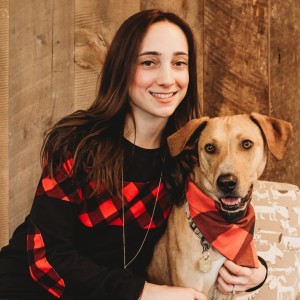
Danielle Vrabel, CPDT-KA
Danielle Vrabel is a dog trainer who earned her CPDT-KA in 2020. Danielle is a proud pet mom of five pets: two dogs, two cats, and a corn snake. Danielle has fostered over ten dogs and fifteen cats and kittens, as well as helped train shelter dogs before they are adopted. Both of Danielle’s dogs are pet therapy dogs, where she also volunteers her time helping evaluate future therapy dogs.
Related articles
![Dog on leash sitting on a colorful street and looking attentive at their pet parent]()
How to Get Your Dog to Pay Attention to You
Here are some simple steps to pry your pup away from that one spot in the yard they’re obsessed with.
![Person walking their dog in the street]()
How to Leash-Train a Puppy or Dog
Don’t let your new dog walk you.
![Brown dog with merle coat running towards the camera on a forest path with a woman standing in the fall distance calling out to him]()
“How Do I Get My Dog to Come When Called?”
Kinship Collective dog trainer Robert Haussmann’s tips for getting a stubborn pup to listen up.
![woman gives small black dog treat for sitting]()
Your Dog Should Do This 30-Day Training Challenge
It’s like your 30-day yoga challenge — except with way more training treats.
![A puppy outside on a leash]()
How to Potty Train a New Puppy
Tips you’ll want to pay attention to.
